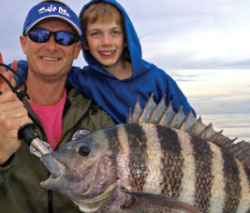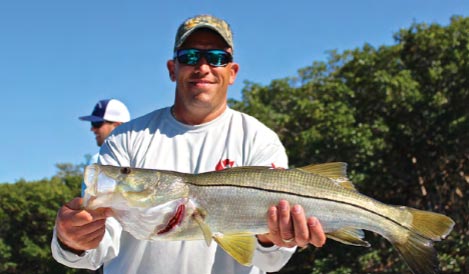Accuracy counts. From inshore to offshore there’s a fine line between successfully connecting with fish and just going for a boat ride. The ability to consistently produce is what separates skilled anglers from the rest of the pack.
On the inshore scene, casting precision is the key to success. Whether blind casting an open at, fishing docks, mangroves, or sight casting to a specific fish, accuracy is necessary. Every cast should be placed to a specific location.
On an open grass at there are subtle differences that should be focused on. Making a cast to the center of a sandy hole or working the perimeter should be a premeditated decision and not just a matter of luck. Species-specific casts can be made in this scenario. Think flounder in the middle and trout on the edges and you’ll begin to understand.
On docks, casts should be made between intentional pilings up under the dock. The difference in a perfect cast and a total blooper can be a matter of inches. One connects with a sh, the other puts you in time out re-tying your tackle.
Mangroves are not much different than docks. Pick your points, limbs, oyster clusters, or other features and re a cast in accurately. An advanced technique is to use your index finger to feather or stop the line on the spool of a spinning reel just as a bass caster would use his thumb.
Sight casting presents an entirely new set of rules. First and fore- most is obtaining the ability to discern which end of the target eats, and which end swims. The margin of error is greatly reduced and may often be on the move. Combine this with a ticking clock of when your target realizes you are present and you have graduated into the next level of precision casters. If your tool of choice is a fly rod in this scenario, you’re reaching for the Holy Grail.
Switching gears to the offshore scene, boat position is just as critical as an inshore cast. When bottom fishing, dropping baits to a precise location on a ledge, reef, or wreck is critical. Being a few feet off is often the difference in catch- ing sh or not.
Dropping baits to a grouper’s doors step takes anchoring skill. Knowing that the snapper are hanging on the highest relief of a structure and presenting baits in that zone from may feet above takes practice and experience.
Calculating wind direction, tidal ow, and depth to accurately drop baits into the strike range can be a calculated guess at best. There are no visual clues offshore as there are inshore. Understanding your electronics readings are paramount.
When considering inshore precision casting and offshore precision anchoring, it becomes apparent that it’s a huge lesson in geometry. It’s a 3-dimensional playing eld and thus the term “angling” has been aptly applied to our passion- ate pastime.
Capt. Brent Gaskill is a 4th generation Tampa Bay native and full-time fishing guide, both inshore and offshore. He can be reached at 727-510-1009 or e-mail captbrent@summervacationcharters.com.





